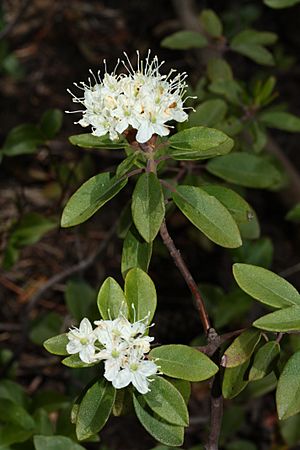Western Labrador tea facts for kids
Quick facts for kids Western Labrador tea |
|
|---|---|
 |
|
| Scientific classification | |
| Kingdom: | |
| (unranked): | |
| (unranked): | |
| (unranked): | |
| Order: | |
| Family: | |
| Genus: | |
| Species: |
R. columbianum
|
| Binomial name | |
| Rhododendron columbianum (Piper) Harmaja
|
|
| Synonyms | |
|
|
Rhododendron columbianum, often called western Labrador tea, swamp tea, or muskeg tea, is a common shrub. You can find it across the western United States and western Canada. It grows in places like British Columbia, Alberta, Washington, Oregon, Idaho, California, Montana, Wyoming, Utah, Nevada, and Colorado.
This plant likes wet areas, from sea level up to about 3,500 meters (11,500 feet) high. It used to be known by a different name, Ledum columbianum. This plant has been around since the late Pliocene era, which was millions of years ago.
Contents
What Western Labrador Tea Looks Like
Rhododendron columbianum is a shrub that can grow up to 2 meters (about 6.5 feet) tall. It spreads out using underground stems called rhizomes. These rhizomes help new plants grow from the main one.
The leaves stay green all year round, so they are called evergreen. They are shaped like an oval or a spear. If you crush the leaves, they have a nice smell. The flowers are white to cream-colored and grow in groups of 10 to 35. The leaves grow very close to the main stem, and their undersides have tiny white hairs.
How Western Labrador Tea Got Its Name
The History of Its Name
Rhododendron columbianum was first named Ledum columbianum. That's why you might see its old name in many older books. In 2009, two scientists, Kathleen A. Kron and Walter S. Judd, decided that the Ledum group of plants looked very similar to the Rhododendron group.
Because they were so alike, the scientists combined them into the larger Rhododendron group. This change meant the plant's official name became Rhododendron columbianum. The plant was even removed from a special list of wetland plants in 2012. But it was added back in 2013 with its new Rhododendron name. Today, both Rhododendron columbianum and Rhododendron groenlandicum are known as Labrador tea.
Plant Family Tree
Scientists have found a very old plant fossil of R. columbianum in Washington. This fossil dates back to the late Pliocene period. This shows that the plant has been around for a very long time.
Studies also show that R. columbianum can be created by mixing the genes of R. groenlandicum and R. neoglandulosum. This means these plants are closely related. Other studies looking at the plant's genes suggest that R. columbianum and R. tolmachevii are very close relatives. They are also related to R. groenlandicum, R. hypoleucum, and R. tomentosum.
Uses of Western Labrador Tea
People have used Rhododendron columbianum for its helpful properties. It has been used in teas for health reasons. For example, it was used to help the body get rid of extra water (diuretic) or to help you sweat (diaphoretic). It was also used to help with digestion (laxative) and to tighten body tissues (astringent).
However, it's important to know that if the tea is made too strong, it can be harmful. The plant's strong smell from its leaves has also been found useful. It can help keep insects and small animals like rodents away.

